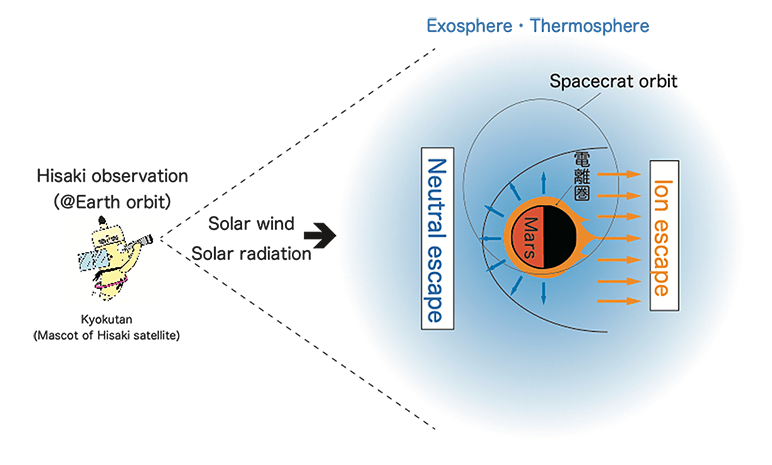Searching for the fate of water on Mars: Atmospheric escape to space
Dec. 21, 2023 | Aerospace Project Research Associate, ISAS people
Research Summary
Mars today has a cold and dry climate, with no liquid water on its surface. However, based on topographic features obtained from recent observations, it is believed that Mars in the past had a warmer climate and oceans existed on its surface (Fig. 1). How did the once existing oceans disappear? Currently, there are two theories: one is that water was transported underground and remains as ice, and the other is that hydrogen and oxygen, the constituent elements of water, have leaked into space in the form of gases. I am conducting observational studies of the Martian atmosphere from the latter perspective in order to understand the whereabouts of water on the Martian surface that existed in the past.

So how do we observe the atmospheric escape from Mars? One method is to monitor the Martian upper atmosphere with a telescope (Fig. 2). Particles such as hydrogen and oxygen atoms emit light by scattering solar ultraviolet radiation, and by monitoring this light with a telescope, we can determine the distribution of hydrogen and oxygen gases around Mars and how it changes over time. Ultraviolet rays are absorbed by the Earth's atmosphere and do not reach the ground, so we need to observe them from above the Earth's atmosphere , i.e., with a space telescope. Using JAXA's Hisaki satellite, we have shown that the total amount of hydrogen and oxygen gases in the upper atmosphere of Mars varies greatly due to seasonal dust storms on the Martian surface [1]. It was also suggested that this is due to the rapid transport of water vapor, which is present in a small fraction of the Martian atmosphere, into the upper atmosphere due to the rapid changes in atmospheric circulation caused by dust storms. The fact that the atmospheric escape occurring between the atmosphere and space (above 100 km altitude) is related to phenomena occurring on the Martian surface is surprising and interesting, and research on the effects of dust storms on atmospheric outflow is currently underway around the world.

Another method is to directly measure the particles of atmospheric components that escape from Mars. In planetary atmospheres above 100 km altitude, a part of the atmosphere is ionized by ultraviolet radiation from the sun. On Mars, this ionized atmosphere is accelerated by the solar wind (the flow of plasma and magnetic fields blown from the sun) and escapes into space (Fig. 2). By installing a device to analyze the energy and mass of the plasma on a planetary probe and measuring the velocity distribution of the plasma as it orbits the planet, we can investigate the escape mechanism of the ionized atmosphere. I worked at research institutes in the U.S. and Europe, and investigated the acceleration mechanism of plasma outflow from Mars using observation data from U.S. and European Mars orbiters, and discovered the characteristic motion of oxygen ions around Mars [2]. ISAS has been developing such plasma instruments and has been installed on various space exploration missions. I mainly analyze observational data to elucidate physical phenomena around planets, and deep knowledge of observational instruments is necessary to analyze the data. I think the good thing about ISAS is the environment in which I can immediately talk with experts in such instruments.
Currently, JAXA plans the Martian Moons Exploration (MMX) mission, the main goal of which is to bring back samples of Phobos, a Martian satellite (a Martian moon), to elucidate the origin of the Martian satellite. On the other hand, Phobos is exposed to the atmosphere that has escaped from Mars, and it is believed that components of the Martian atmosphere are transported to the surface of Phobos. Therefore, it is expected that the analysis results of the samples brought back to the site will help us derive the weathering effects of the Martian atmosphere. I hope to understand the mechanism of atmospheric outflow from Mars, which will also lead to the understanding of the Martian satellite environment that future MMX will reveal.
- K. Masunaga et al., Nature Communications, 13, 6609, 2022, doi:10.1038/s41467-022-34224-6
- K. Masunaga et al., J. Geophys. Res. Space Physics, 121, 3093–3107, 2016, doi:10.1002/2016JA022465
- K. Kuramoto et al., Earth, Planets and Space, 74, 12, 2022, doi:10.1186/s40623-021-01545-7


 MASUNAGA Kei / Dept. of Solar System Science, ISAS
MASUNAGA Kei / Dept. of Solar System Science, ISAS